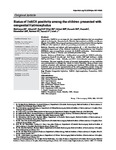Status of ToRCH positivity among the children presented with congenital Hydrocephalus
| dc.contributor.author | Mukherjee, SK | |
| dc.contributor.author | Arman, DM | |
| dc.contributor.author | Roy, Holly | |
| dc.contributor.author | Khan, RK | |
| dc.contributor.author | Afreen, S | |
| dc.contributor.author | Hossain, MA | |
| dc.contributor.author | Md Ziauddin, - | |
| dc.contributor.author | Ekramullah, SM | |
| dc.contributor.author | Rahman, MM | |
| dc.contributor.author | Yusuf, MA | |
| dc.contributor.author | Islam, MJ | |
| dc.date.accessioned | 2022-03-07T14:18:27Z | |
| dc.date.available | 2022-03-07T14:18:27Z | |
| dc.date.issued | 2020-01-14 | |
| dc.identifier.issn | 2411-6637 | |
| dc.identifier.issn | 2664-7915 | |
| dc.identifier.uri | http://hdl.handle.net/10026.1/18908 | |
| dc.description.abstract |
<jats:p>Introduction: ToRCH is an acronym for four congenital infections that are sometimes difficult to distinguish: Toxoplasmosis, Rubella, Cytomegalovirus (CMV), and Herpes Simplex Virus (HSV). This group of organisms produces serious Central Nervous System (CNS) and other infections, which are potentially preventable and treatable.
 Methods: Neonates and infants with hydrocephalus (N = 65) identified via the outpatient department of the National Institute of Neurosciences and Hospital (NINS&H), were prospectively screened for ToRCH antibodies. Hydrocephalus secondary to Tumor or Trauma was excluded from this study.
 Results: Evidence of 75.38 % (p = <0.05) patient was positive for TORCH antibodies. Toxoplasma Gondi (T. Gondii) IgG 18.5 % ( p= <0.05 ), CMV IgM 9.2 % (p = <0.05), CMV Ig G47.7% ( p = <0.5), Rubella, and HSV 1 & 2 antibodies were also identified.
 Conclusion: The vast majority of cases of neonatal hydrocephalus at one institution was post-infectious in etiology and related to ToRCH infections. Many of these cases could be prevented with improved screening and treatment. While study of a single institution may not be the representative of the entire population, further study and implementation of a standardized screening protocol would likely benefit this population.
 Bang. J Neurosurgery 2020; 9(2): 121-125</jats:p> | |
| dc.format.extent | 121-125 | |
| dc.language.iso | en | |
| dc.publisher | Bangladesh Journals Online (JOL) | |
| dc.subject | Pediatric | |
| dc.subject | Neurosciences | |
| dc.subject | Hydrocephalus | |
| dc.subject | Prevention | |
| dc.subject | Infectious Diseases | |
| dc.subject | Brain Disorders | |
| dc.subject | Sexually Transmitted Infections | |
| dc.subject | Emerging Infectious Diseases | |
| dc.subject | Infection | |
| dc.title | Status of ToRCH positivity among the children presented with congenital Hydrocephalus | |
| dc.type | journal-article | |
| plymouth.issue | 2 | |
| plymouth.volume | 9 | |
| plymouth.publication-status | Published online | |
| plymouth.journal | Bangladesh Journal of Neurosurgery | |
| dc.identifier.doi | 10.3329/bjns.v9i2.44886 | |
| plymouth.organisational-group | /Plymouth | |
| plymouth.organisational-group | /Plymouth/Faculty of Health | |
| plymouth.organisational-group | /Plymouth/Faculty of Health/Peninsula Medical School | |
| plymouth.organisational-group | /Plymouth/REF 2021 Researchers by UoA | |
| plymouth.organisational-group | /Plymouth/REF 2021 Researchers by UoA/UoA01 Clinical Medicine | |
| plymouth.organisational-group | /Plymouth/Research Groups | |
| plymouth.organisational-group | /Plymouth/Research Groups/FoH - Applied Parkinson's Research | |
| plymouth.organisational-group | /Plymouth/Users by role | |
| plymouth.organisational-group | /Plymouth/Users by role/Academics | |
| plymouth.organisational-group | /Plymouth/Users by role/Researchers in ResearchFish submission | |
| dcterms.dateAccepted | 2019-04-16 | |
| dc.rights.embargodate | 2022-3-8 | |
| dc.identifier.eissn | 2664-7915 | |
| dc.rights.embargoperiod | Not known | |
| rioxxterms.versionofrecord | 10.3329/bjns.v9i2.44886 | |
| rioxxterms.licenseref.uri | http://www.rioxx.net/licenses/all-rights-reserved | |
| rioxxterms.licenseref.startdate | 2020-01-14 | |
| rioxxterms.type | Journal Article/Review |


